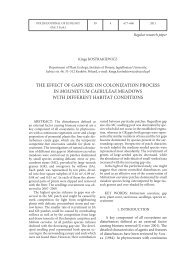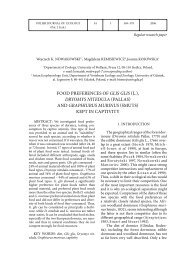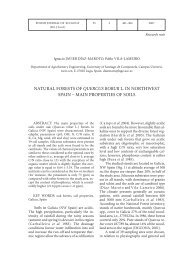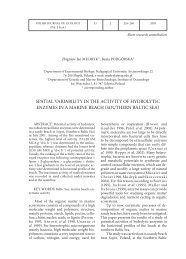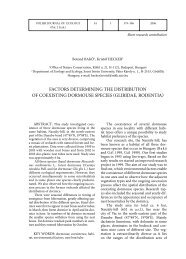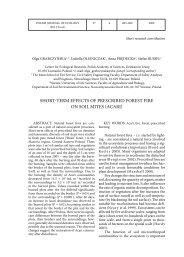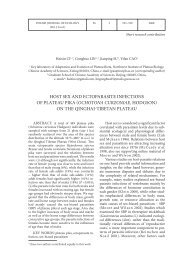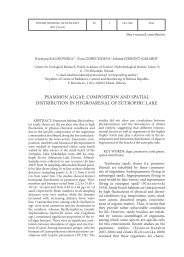CENTRAL-PLACE FORAGING IN AN URBAN LANDSCAPE: BODY ...
CENTRAL-PLACE FORAGING IN AN URBAN LANDSCAPE: BODY ...
CENTRAL-PLACE FORAGING IN AN URBAN LANDSCAPE: BODY ...
Create successful ePaper yourself
Turn your PDF publications into a flip-book with our unique Google optimized e-Paper software.
POLISH JOURNAL OF ECOLOGY<br />
(Pol. J. Ecol.)<br />
58 2 387–392 2010<br />
Short research contribution<br />
Justyna KUBACKA 1 *, Michał ŻMIHORSKI 2 , Paweł MIRSKI 3 , Łukasz REJT 4<br />
1<br />
Institute of Environmental Studies, Jagiellonian University, Gronostajowa 7, 30-387 Kraków, Poland<br />
*e-mail: justyna.kubacka@uj.edu.pl (corresponding author)<br />
2<br />
Museum and Institute of Zoology, Polish Academy of Sciences, Wilcza 64, 00-679 Warszawa, Poland<br />
3<br />
Institute of Biology, University of Białystok, Świerkowa 20B, 15-950 Białystok, Poland<br />
4<br />
Museum and Institute of Zoology, Polish Academy of Sciences, Wilcza 64, 00-679 Warszawa, Poland<br />
<strong>CENTRAL</strong>-<strong>PLACE</strong> <strong>FORAG<strong>IN</strong>G</strong> <strong>IN</strong> <strong>AN</strong> URB<strong>AN</strong> L<strong>AN</strong>DSCAPE:<br />
<strong>BODY</strong> MASS OF COMMON VOLES (MICROTUS ARVALIS PALL.)<br />
CAUGHT BY BREED<strong>IN</strong>G KESTRELS (FALCO T<strong>IN</strong>NUNCULUS L.) IS<br />
POSITIVELY CORRELATED WITH AVAILABILITY OF HUNT<strong>IN</strong>G SITES<br />
ABSTRACT: In the reproduction period<br />
a male Kestrel (Falco tinnunculus) is a centralplace<br />
forager, i.e. it transports food from hunting<br />
grounds to a central location – the nest. A centralplace<br />
forager is predicted to take larger or more<br />
prey when distance to a foraging site is longer.<br />
We studied kestrels breeding in a large Central<br />
European city (population 1.7 million), whose<br />
main prey are common voles (Microtus arvalis).<br />
Kestrel nests are located in the centre and the outskirts,<br />
although common voles are scarce in the<br />
former. The aim of our study was to analyse the<br />
body mass of common voles found in pellets under<br />
kestrel nests and relate it to the availability of<br />
common vole habitats within 1 km from the nests,<br />
controlled for vole frequency in the pellets. We<br />
assumed that the greater availability of common<br />
vole habitats, the shorter the distance to a foraging<br />
site. We found that the body mass of common<br />
voles found in pellets was significantly positively<br />
correlated with the availability of their habitats,<br />
but was not affected by their frequency in pellets.<br />
Our results may indicate that, contrary to the central-place<br />
foraging rule, and irrespectively of the<br />
amount of other prey taken, the kestrels hunted<br />
smaller voles when foraging grounds were further<br />
away. This might stem from decreased selectivity<br />
caused by competition, either in the native territory<br />
(due to the high density of kestrels in the centre)<br />
or in territories of outskirt kestrels, invaded<br />
by city centre kestrels. On the other hand, due to<br />
lack of data on the body size of common voles in<br />
our study area, the results may suggest that common<br />
voles were on average smaller in the centre<br />
than in the outskirts. Although the published data<br />
do not support the second explanation, more research<br />
is needed to verify this.<br />
KEY WORDS: prey size selection, competition,<br />
urban environment<br />
In the breeding season, birds make repeated<br />
excursions from and back to a central location,<br />
such as a nest, to which they carry food.<br />
This is an instance of central-place foraging<br />
(Orians and Pearson 1979). It has been<br />
shown that the choice of prey type and size by<br />
central-place foragers is affected by distance<br />
to foraging grounds, competition, demand at<br />
the delivery point (determined by e.g. brood<br />
size) and variance-sensitivity (Ydenberg<br />
2007). For example, many studies found that<br />
when distance to foraging grounds increased,<br />
so did food load transported by a centralplace<br />
forager (e.g. Kacelnik 1984, Krebs<br />
and Aver y 1985, Gil and Pleguezuelos<br />
2001). Also, in Eastern Chipmunks Tamias<br />
stratus load size decreased in the presence<br />
of competitors at resource collection points<br />
(Giraldeau et al. 1994).<br />
We studied central-place foraging patterns<br />
in the urban population of European<br />
journal 22 v02.indb 387 2010-06-18 20:20:40
388<br />
Justyna Kubacka et al.<br />
Kestrels Falco tinnunculus (L.) in Warsaw,<br />
Poland. These raptors specialise in microtine<br />
voles, especially in Central and Northern Europe<br />
(e.g. Korpimäki 1985, Village 1990).<br />
The Warsaw kestrels, although urban dwellers,<br />
have also been confirmed to be vole specialists,<br />
feeding predominantly on Common<br />
Voles Microtus arvalis (Pallas), which comprise<br />
approximately 70–80% of their prey as<br />
estimated from pellets (Romanowski 1996,<br />
Rejt 2001, Ż mihorski and Rejt 2007). This<br />
prey occurs in the outskirts but is thought to<br />
be rare or absent in the city centre, where<br />
its habitat is scarce and patchy, and which is<br />
dominated by synurbic rodent species, such<br />
as the Striped Field Mouse Apodemus agrarius<br />
(Andrzejewski et al. 1978, Białożej 2003,<br />
Gryz et al. 2008, Gliwicz unpubl.). Kestrels<br />
build nests both in the centre and outskirts of<br />
Warsaw, but they breed especially densely in<br />
the former, where chances for catching a vole<br />
close to the nest are very low.<br />
The aim of our study was to examine the<br />
body mass of common voles caught by Warsaw<br />
kestrels in the breeding season (March<br />
and April), when they are central-place foragers,<br />
and relate it to the percentage of common<br />
vole habitats within 1 km from the nest. We<br />
used this percentage as an indicator of probability<br />
that a kestrel hunts further away from<br />
its central place (the nest), i.e. the more vole<br />
habitats within 1 km from a nest, the closer to<br />
it a kestrel is predicted to hunt. We expected<br />
the body mass of common voles preyed by<br />
kestrels to be negatively correlated with the<br />
amount of common vole habitats within 1 km<br />
from a kestrel’s nest.<br />
We analysed kestrel pellets gathered as<br />
part of a larger study. The pellets were collected<br />
in 1998, 1999 and 2001, under 11 different<br />
kestrel nests situated within the administrative<br />
boundaries of Warsaw, Central Poland<br />
(52ºN, 21ºE, area 517 km 2 , population 1.7 million).<br />
We narrowed our interest to the breeding<br />
period, when the male kestrel becomes a<br />
central-place forage r and is virtually the only<br />
food supplier for the female and later also for<br />
the young (Village 1983, Riddle 1993).<br />
It starts feeding his partner during courtship,<br />
which in Warsaw takes place mainly in<br />
March, and continues over the incubation period<br />
(3 rd decade of March – end of April) and<br />
the young rearing period, when he supplies<br />
food for the incubating female and later for<br />
the whole family (Śliwa and Rejt 2006). Because<br />
in the region of our study common voles<br />
are born between April and May (e.g. Adamczewska-Andrzejewska<br />
and Nabagło<br />
1977), we decided to limit our analysis to<br />
March and April. This was done in order to<br />
avoid the confounding effect of change in the<br />
age structure of common vole populations.<br />
The nest surroundings varied in terms of<br />
the amount of habitat suitable for the Common<br />
Vole, such as lawns, fallow land, roadsides,<br />
weed strips, meadows and pastures<br />
(Stein 1958). We calculated the proportion<br />
of these common vole habitats within a 1-km<br />
radius from each of the nests. We assumed<br />
that this proportion negatively correlates with<br />
the distance that Warsaw kestrels need to cover<br />
to find a vole: the more common vole habitats<br />
within 1 km, the shorter the distance. The<br />
proportion of common vole habitats ranged<br />
from 0.7 to 19.6%. For the computations we<br />
used GIS software and 1:10 000 maps (as of<br />
2004), scanned with the resolution of 1 pixel<br />
to 70 cm in the field.<br />
Out of the 11 nest locations some were<br />
sampled in more than one year, whereas others<br />
only in one year. It should be noted that<br />
our replicates are in fact males (as decisionmakers)<br />
and not nest locations, and so we<br />
assumed the pellet sets collected under the<br />
same nests to be independent between years.<br />
This is justified by the fact that kestrels typically<br />
change partners between years (e.g.<br />
Palokangas et al. 1992). Thus, it is unlikely<br />
that from 1998 to 2001 a pair breeding in a<br />
given location comprised the same male.<br />
From the pellets we dissected all skeletal<br />
elements, according to a standard method<br />
(Raczyński and Ruprecht 1974). Bones of<br />
common voles were identified to the species<br />
level with the identification key by Pucek<br />
(1984). Next, mandibular first molars (M1s)<br />
were separated from common vole jaws and<br />
their length was measured. Most pellets<br />
contained remainings of 1 vole individual,<br />
in which case we randomly selected one of<br />
the two M1s for measurement. If there were<br />
more (2 or 3) individuals in a pellet, either<br />
left or right M1s were measured. Teeth that<br />
showed digestion traces (i.e. were rounded)<br />
or mechanical damage (i.e. were broken or<br />
cracked) were discarded. Measurements were<br />
journal 22 v02.indb 388 2010-06-18 20:20:40
Size of common vole prey in breeding urban Kestrels<br />
389<br />
taken with a vernier calliper, to the nearest<br />
0.02 mm, using a 2.3 × Zeiss eyepiece. We<br />
also used data on percentage frequency of<br />
Microtus voles in the pellets relative to other<br />
prey (calculated for different purposes). From<br />
other studies on Warsaw kestrels (e.g. Rejt<br />
2004, Ż mihorski and Rejt 2007) we know<br />
that Microtus arvalis is dominant in their diet<br />
and very rarely M. oeconomus and M. agrestis<br />
are found. We therefore used percentage<br />
of Microtus voles as an indicator of common<br />
vole frequency in the pellets that we analysed.<br />
It was calculated separately for each nest and<br />
year, and was based on the average of 67.0 ±<br />
49 pellets (min. 16, max. 177).<br />
In the Common Vole, the length of M1 is<br />
significantly positively correlated with body<br />
mass (r = 0.63, P< 0.001, Balčiauskienė<br />
2007). Because the Kestrel easily digests<br />
bones of rodents, usually only their skulls or<br />
jaws are present in pellets (e.g. Yalden 1980).<br />
Consequently, M1 appears to be one of the<br />
best indicator of body mass of common voles<br />
identified in kestrel pellets. We converted all<br />
the M1 measurements into body mass values,<br />
using the linear regression formula by<br />
Balčiauskienė (2006), and body mass was<br />
used for further analysis.<br />
In total, we measured 562 M1s of common<br />
voles (Table 1). We excluded the nests<br />
for which the number of M1 measurements<br />
in a given year was smaller than 4. For each<br />
of the remaining nests all M1 lengths were<br />
averaged, separately for each year. The distribution<br />
of individual measurements, categorised<br />
by year, was slightly skewed to the<br />
left, but divergence from normality was significant<br />
only for 1999. The dependent variable<br />
– mean body mass per nest in a given<br />
year – did not diverge from normality. We<br />
then applied a general linear mixed model to<br />
test for the effect of year (random), % common<br />
vole habitats (covariate), % voles in pellets<br />
(covariate) and the interactions: year x %<br />
common vole habitats, year x % voles in pellets<br />
and % common vole habitats x % voles<br />
in pellets on the body mass of the common<br />
voles. The percentage variables were not<br />
transformed, but their arc-sine transformation<br />
yielded the same final model and results<br />
(not shown). The dependent variable, mean<br />
body mass of common voles per nest in a<br />
given year, was weighted by frequencies on<br />
which the means were based. The random<br />
effects hypotheses in the model were tested<br />
with the Wald Z test and the fixed effects<br />
hypotheses with the F-test. We applied backward<br />
selection and the AIC value (Akaike<br />
information criterion) to reduce the number<br />
of predictors and find the most parsimonious<br />
model explaining variation in body mass<br />
(Quinn and Keough 2002). The lowest<br />
AIC model is considered to explain the most<br />
variation in the response variable with the<br />
lowest number of independent variables. We<br />
used the corrected AIC value (AIC c<br />
), which<br />
should be applied when sample sizes are<br />
small, as in our case (N = 19). For statistical<br />
analysis we used SAS 9.1 (with Enterprise<br />
Guide 4.1) and Statistica 8.0.<br />
The ΔAIC C value of the initial model<br />
was 21.6 and all the factors and interactions<br />
were non-significant. Backward elimination<br />
of the least significant predictors (beginning<br />
from interactions) always resulted in decreasing<br />
the AIC C . After removal of all the three<br />
interactions from the model (P> 0.150 in all<br />
cases, not shown) the common vole frequency<br />
remained non-significant (P = 0.550, not<br />
shown), and consequently was dropped from<br />
the model as well. The most parsimonious<br />
model (with ΔAIC C = 0) retained ‘year’ and<br />
‘% common vole habitats’ (Table 2).<br />
The amount of common vole habitats<br />
within 1 km from the nest of the kestrels was<br />
significantly positively correlated with the<br />
body mass of common voles caught by the<br />
kestrels (F (0.05;1,15)<br />
= 6.98, P = 0.018). The model<br />
predicts that the kestrels with the highest<br />
percentage of common vole hunting grounds<br />
Table 1. Number (No) of kestrel nests sampled in each year of the study out of the total of 11 nests, and<br />
the mean number of measurements of mandibular first molars of the common voles found in the pellets<br />
collected under the nests (±SD).<br />
year No of nests M1s/nest<br />
1998 7 23.3 ± 14.2<br />
1999 5 28.0 ± 21.3<br />
2001 7 37.0 ± 29.6<br />
journal 22 v02.indb 389 2010-06-18 20:20:40
390<br />
Justyna Kubacka et al.<br />
Table 2. Results from the most parsimonious general linear mixed model, testing for the effect of year<br />
and % common vole habitats within 1 km radius from the nests of kestrels Falco tinnunculus on the<br />
body mass of common voles Microtus arvalis caught by the kestrels at the beginning of the breeding<br />
season (March–April), in the years 1998–1999 and 2001 in Warsaw.<br />
Source of variation statistic p-value<br />
Random effects<br />
Z-value<br />
year 0.93 0.176<br />
residual 2.74 0.003<br />
Fixed effect<br />
F-value<br />
% common voles habitats 6.98 0.018<br />
Fig. 1. Relationship between percent common vole (Microtus arvalis) habitats within 1-km radius from<br />
the nests of urban kestrels (Falco tinnunculus) and the body mass of common voles found in pellets collected<br />
under the nests in 1998–1999 and 2001, in Warsaw, Poland. Each data point corresponds to one<br />
nest in a given year. Symbol size denotes number of measurements per each nest in a given year.<br />
(19.6%) on average catch voles that are 1.8<br />
g heavier than in the case of the birds with<br />
the lowest ranking hunting grounds (0.7%)<br />
(Fig. 1). The body mass of common vole prey<br />
captured by the kestrels did not differ significantly<br />
between the years (P = 0.176). The mean<br />
frequency of Microtus voles in the pellets was<br />
85 ± SD 14%, and the range was 58 to 100%.<br />
Contrary to the expectations, our results<br />
showed that the body mass of common voles<br />
caught by urban kestrels increased with the<br />
amount of common vole habitats within 1 km<br />
from the nest (Table 2, Fig.1). Importantly,<br />
both the percent frequency of voles in the pellets<br />
(of which the Common Vole was dominant)<br />
and its interaction with the percent<br />
common vole habitats were non-significant.<br />
These results may suggest that kestrels, when<br />
central-place foragers, are less selective when<br />
opportunities to find a vole close to their<br />
central location are worse, irrespectively of<br />
the relative number of alternative prey they<br />
consume. One of the causes of decreased selectivity<br />
in central foragers may be intraspecific<br />
competition, as observed in the Eastern<br />
Chipmunk (Giraldeau et al. 1994). In Warsaw,<br />
kestrels reach high densities (approx. 1.2<br />
pairs per 10 km 2 ), and nest especially densely<br />
in the city centre (approx. 25.7 pairs per 10<br />
km 2 ) (Luniak et al. 2001), which offers extremely<br />
limited common vole resources. It<br />
follows that kestrels occupying territories<br />
journal 22 v02.indb 390 2010-06-18 20:20:40
Size of common vole prey in breeding urban Kestrels<br />
391<br />
with small amount of common vole habitats<br />
must suffer increased intraspecific competition<br />
for their main prey and consequently<br />
may be less selective towards the size of<br />
this prey. It is also possible that the kestrels<br />
which nest in territories poorer in common<br />
vole habitats visit more distant common vole<br />
patches. This is consistent with observations<br />
of Riegert et al. (2007) in the Czech Republic,<br />
who found that territories of city-centre<br />
kestrel males, with scarcer vole habitats, were<br />
larger than and overlapped with territories of<br />
outskirts kestrels. This suggests that city centre<br />
kestrels may forage in more distant hunting<br />
grounds, which are occupied by other<br />
kestrels. In our study kestrels with fewer common<br />
vole habitats in their territories may have<br />
invaded richer territories of other kestrels,<br />
which eventually may have lead to enhanced<br />
competition between ‘intruders’ and ‘owners’<br />
of a territory. It should be emphasized that<br />
since in the breeding season the male kestrel<br />
is a central-place forager, it should carry<br />
larger prey when it covers longer distance to<br />
hunting grounds (e.g. Ydenberg 2007). Our<br />
results suggest an opposite pattern, pointing<br />
out that other factors, such as competition,<br />
may interact with this optimal foraging rule.<br />
This result, to our knowledge, has only been<br />
documented in the case of mammalian foragers,<br />
Eastern Chipmunks.<br />
On the other hand, our results might be<br />
confounded by variation in body mass in the<br />
common vole populations in our study area,<br />
for which we did not control. First, it is probable<br />
that in the different kestrel hunting territories<br />
the population dynamics of the Common<br />
Vole was asynchronous (e.g. in some<br />
locations voles started breeding earlier than in<br />
others, and the mean body mass in their populations<br />
was lower). It has been shown, however,<br />
that common vole populations inhabiting<br />
areas that are relatively close to each other<br />
may be expected to breed at the same time in<br />
a given year (e.g. Adamczewska-Andrzejewska<br />
and Nabagło 1977, Mackin-Rogalska<br />
and Nabagło 1990). Second, since<br />
the potential vole habitats located in the centre<br />
are smaller and patchier, which implies<br />
that they are poorer and more vulnerable to<br />
disturbance, common voles may be expected<br />
to be smaller in the centre and larger in the<br />
outskirts. However, Jacob (2003) reported<br />
that in more disturbed agricultural land (crop<br />
field, pasture) body weight of common voles<br />
was higher than in less disturbed areas. This<br />
suggests that common voles may not necessarily<br />
be smaller in the city centre. Third, it is<br />
also possible that common vole densities vary<br />
between the centre and the outskirts, and that<br />
there are density-dependent effects on body<br />
mass in these populations (Chitty 1952).<br />
Finally, due to the low amount of suitable<br />
habitats the city centre common voles may be<br />
subordinate, and hence smaller individuals<br />
forced to the sub-optimal area of the city. In<br />
general, we cannot conclusively say that the<br />
pattern that we found stems from selectivity<br />
of the kestrels and not differences in common<br />
vole populations between the hunting sites.<br />
In sum, we observed that the amount of<br />
vole habitats within 1 km from the nests of<br />
kestrels is positively correlated with the size<br />
of their main prey – the Common Vole. We<br />
propose that our result may suggest a relationship<br />
between availability of hunting sites<br />
and selectivity in the kestrels, which may be<br />
decreased by competition either in a bird’s<br />
territory (given the very high kestrel density<br />
in Warsaw) and/or in territories of other individuals,<br />
visited by the kestrels whose territories<br />
are scarcer in voles. In the latter case,<br />
it is plausible that competition may alter the<br />
effect of distance to foraging grounds on prey<br />
size selection by kestrels. It should be stressed<br />
that we did not control for the abundance or<br />
body mass structure of common vole populations<br />
at the nest locations which we studied,<br />
and hence it is also possible that our results<br />
stem from these factors and not selectiveness<br />
of the kestrels. Although literature data does<br />
not lend support for this explanation, more<br />
research is needed to clarify this.<br />
ACKNOWLEDGMENTS: We thank R.<br />
Martyka, T. Mazgajski and anonymous reviewers<br />
for valuable comments on a draft of this paper. M.<br />
Cichoń and P. Chylarecki provided statistical advice.<br />
REFERENCES<br />
Adamczewska-Andrzejewska K.A.,<br />
Nabagło L. 1977 – Demographic Parameters<br />
and Variations in Numbers of the Common<br />
Vole – Acta Theriol. 22: 431–457.<br />
journal 22 v02.indb 391 2010-06-18 20:20:41
392<br />
Justyna Kubacka et al.<br />
Andrzejewski R., Babińska-Werka J.,<br />
Gliwicz J., Goszczyński J. 1978 – Synurbization<br />
process in population of Apodemus<br />
agrarius. I. Characteristics of populations in<br />
an urbanization gradient – Acta Theriol. 23:<br />
341–358.<br />
Balčiauskienė L. 2006 – Feeding ecology of<br />
Tawny Owl (Strix aluco) and Long-eared Owl<br />
(Asio otus) based on craniometry of prey –<br />
Ph.D. thesis, Institute of Ecology, Vilnius University.<br />
Balčiauskienė L. 2007 – Cranial growth of<br />
captive bred Common Voles Microtus arvalis<br />
– Acta Zool. Lith. 17: 220–227.<br />
Białożej M. 2003 – Wpływ struktury przestrzennej<br />
terenów kolejowych na populację<br />
małych ssaków [Influence of spatial structure<br />
of railway areas on the small mammal community]<br />
– MSc thesis, Department of Ecology,<br />
University of Warsaw (in Polish).<br />
Chitty D. 1952 – Mortality among voles (Microtus<br />
agrestis) at Lake Vymwy, Montgomeryshire<br />
in 1936-9 – Phil. Trans. R. Soc. Lond.<br />
B, 36:505–552.<br />
Gil J.M., Pleguezuelos J. M. 2001 – Prey<br />
and prey-size selection by the short-toad eagle<br />
(Circaetus gallicus) during the breeding season<br />
in Granada (South-Eastern Spain) – J. Zool.<br />
255: 131–137.<br />
Giraldeau L.A., Kramer D.L., Deslandes<br />
I., Lair H. 1994 – The effect of competitors<br />
and distance on central place foraging in Eastern<br />
Chipmunks, Tamias striatus – Anim. Behav.<br />
47: 621–632.<br />
Gryz J., Krauze D., Goszczyński J. 2008<br />
– The small mammals of Warsaw as inferred<br />
from Tawny Owl (Strix aluco) pellet analyses –<br />
Ann. Zool. Fenn. 45: 281–285.<br />
Jacob J. 2003 – Body weight dynamics of common<br />
voles in agro-ecosystems – Mammalia,<br />
67: 559–566.<br />
Kacelnik A. 1984 – Central place foraging in<br />
Starlings (Sturnus vulgaris). I. Patch residence<br />
time – J. Anim. Ecol. 53: 283–99.<br />
Korpimäki E. 1985 – Diet of the Kestrel Falco<br />
tinnunculus in the breeding season – Ornis<br />
Fennica, 62: 130–137.<br />
Krebs J.R., Avery M.I. 1985 – Central place<br />
foraging in the European Bee-Eater (Merops<br />
apiaster) – J. Avian Ecol. 54: 459–472.<br />
Luniak M., Kozłowski P., Nowicki W.,<br />
Plit J. 2001 – Ptaki Warszawy 1962–2000<br />
[Birds of Warsaw 1962–2000] - Atlas Warszawy<br />
8 – IGP i P P<strong>AN</strong>.<br />
Mackin-Rogalska R., Nabagło L. 1990 –<br />
Geographical variation in cyclic periodicity<br />
and synchrony in the Common Vole, Microtus<br />
arvalis – Oikos, 59: 343–348.<br />
Orians G.H., Pearson N.E. 1979 – On the<br />
theory of central place foraging (In: Analysis<br />
of Ecological Systems, Ed: D.J. Horn) – Ohio<br />
State University Press: Columbus, pp.154–177.<br />
Palokangas P., Alatalo R.V., Korpimäki<br />
E. 1992 – Female choice in the Kestrel under<br />
different availability of mating options –<br />
Anim. Behav. 43: 659–665.<br />
Pucek Z. 1984 – Klucz do oznaczania ssaków<br />
Polski [Key to identification of mammals of<br />
Poland] – PWN, Warszawa.<br />
Quinn G.P., Keough M.J. 2002 – Experimental<br />
Design and Data Analysis for Biologists<br />
– Cambridge University Press.<br />
Raczyński J., Ruprecht A.L. 1974 – The effect<br />
of digestion on the osteological composition<br />
of owl pellets – Acta Ornithol. 14: 25–38.<br />
Rejt Ł. 2001 – Peregrine falcon and Kestrel in<br />
urban environment - the case study of Warsaw<br />
(In: Naturschutz und Verhalten, Eds: E. Gottschalk,<br />
A. Barkow, M. Muehlenberg, J. Settele)<br />
– UFZ-Bericht 2: 81–85.<br />
Riddle G.S. 1993 – A 20 year study of the Kestrels<br />
in Ayrshire – Scottish Birds, 17: 9–13.<br />
Riegert J., Fainová D., Mikeš V., Fuchs<br />
R . 2007 – How urban Kestrels Falco tinnunculus<br />
divide their hunting grounds: partitioning<br />
or cohabitation? – Acta Ornithol. 42: 69–76.<br />
Romanowski J. 1996 – On the diet of urban<br />
Kestrels (Falco tinnunculus) in Warsaw – Buteo,<br />
8: 123–130.<br />
Stein G.H.W. 1958 – Die Feldmaus (Microtus<br />
arvalis Pallas) (In: Die Neue Brehm-bücherei)<br />
H. 225 – Wittenberg-Lutherstadt, A. Ziemsen-<br />
Verl.<br />
Śliwa P., Rejt Ł. 2006 – Pustułka [The Kestrel]<br />
– Monografie przyrodnicze, vol. 15, Klub<br />
Przyrodników Press, Świebodzin (in Polish<br />
with English and German summary).<br />
Village A. 1983 – Seasonal changes in the hunting<br />
behaviour of Kestrel – Ardea, 71: 117–123.<br />
Village A. 1990 – The Kestrel – T and A D Poyser,<br />
London.<br />
Yalden D.W. 1980 – Notes on the diet of urban<br />
Kestrels – Bird Study, 27: 235–238.<br />
Ydenberg R.C. 2007 – Provisioning (In: Foraging<br />
– Behavior and Ecology, Eds: D.W. Stephens,<br />
J. Brown, R. Ydenberg) – The University<br />
of Chicago Press, Chicago and London,<br />
pp. 273–304.<br />
Żmihorski M., Rejt Ł. 2007 – Weather-dependent<br />
variation in the cold-season diet of<br />
urban Kestrels Falco tinnunculus – Acta Ornithol.<br />
42: 107–113.<br />
Received after revision August 2009<br />
journal 22 v02.indb 392 2010-06-18 20:20:41




